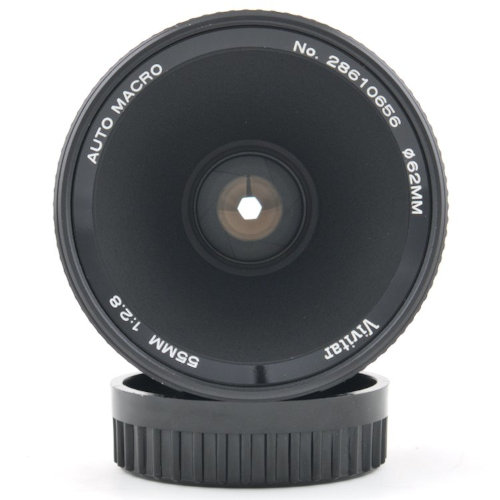Here are reviews of various lenses I have had the chance to review. When I was previously doing this I had taken an interest in vintage macro lenses. I also used many vintange 35mm film lenses as they were inexpensive and easy to find.
Macro Lenses

The Vivitar 55mm f/2.8 is my favorite vintage macro lens. It has slightly better image quality than it’s contemporary competition, while not needing an extension tube to reach 1:1 macro.
- Vivitar 55mm f/2.8 Macro Lens Review
- Lester A Dine 105mm f/2.8 Macro Lens Review
- Canon FD 100mm f/4 Macro Lens Review
- Minolta MD 50mm f/3.5 Macro Lens Review
- Nikon AF Micro Nikkor 105mm f/2.8 Macro Lens Review
- Nikon Micro Nikkor AF 60mm f/2.8 Lens Review
- Nikon PC 55mm f/3.5 Macro Lens Review
- Olympus OM 50mm f/3.5 Zuiko Auto Macro Lens Review
- Panagor 55mm f/3 Macro Lens Review
- Sigma 50mm f/2.8 Macro Lens Review
- Tamron Sp 90mm f/2.5 Macro Adaptall 2 Lens Review
- Tamron Sp Di 90mm f/2.8 Macro AF Lens Review
- Yashica 55mm f/2.8 ML Macro Lens Review
- Vivitar 90mm f/2.8 Macro Lens Review
Canon FD-Mount Lenses
The Canon FD lens mount was introduced by Canon in 1971 as the successor to their previous FL lens mount. The FD mount features a backwards compatible breech-lock mechanism that was supposed to allow for faster and more secure lens changes.
The FD mount was widely used on Canon’s range of manual focus SLR cameras, including the popular F-1 and A-series models. The mount was also compatible with a wide range of FD lenses, which were known for their excellent optical performance and build quality.
However, with the introduction of autofocus technology in the mid-1980s, Canon discontinued the FD mount in favor of the Canon EF lens mount, which allowed for electronic communication between the camera body and the lens.
Here’s more information on the Canon FD lens mount
While there are not very many lenses reviewed, I have gone through and selected the best Canon FD lenses to use for film photography. They are the same for most of the FD cameras, such as the best lenses for the Canon AE-1.
Nikon F-Mount Lenses
The Nikon F-mount is one of the most widely used lens mounts in the history of photography, and it has a rich and fascinating history. The F-mount was first introduced by Nikon in 1959 for their Nikon F camera, which was the world’s first professional-grade 35mm SLR camera.
My favorite Nikon film camera that I have used has been the Nikon FM2. There are so many options, but here are my thoughts on the best Nikon FM2 lenses.
Since then, Nikon has continued to refine and improve the F-mount, introducing new versions with improved functionality and compatibility with newer camera models. This can lead to some compatibility problems, especially with entry leverl DSLR cameras.
- Nikon 28mm f/2.8 Series E Lens Review
- Nikon 50mm f/1.8 Series E Pancake Lens Review
- Nikon AF Micro Nikkor 105mm f/2.8 Macro Lens Review
- Nikon Micro Nikkor AF 60mm f/2.8 Lens Review
- Nikon PC 55mm f/3.5 Macro Lens Review
Minolta MD Lenses (SR Mount)
The Minolta SR lens mount, also known as the MC/MD mount, was introduced in 1958 for Minolta’s SR-2 camera. The mount features a unique bayonet design that allowed for quick and secure lens changes, while also allowing for automatic aperture control with certain lenses.
Over the years, Minolta continued to refine and expand the SR mount, introducing new versions with improved functionality and compatibility with newer camera models. The SR mount was widely used on Minolta’s range of manual focus SLR cameras, including the popular SRT and X-series models. Here are the best Minolta SR-T 101 lenses
The mount was also compatible with a wide range of MC and MD lenses, which were known for their excellent optical performance and build quality.
Olympus OM Mount Lenses
The Olympus OM lens mount was introduced in 1972 as part of Olympus’s OM system, which included a range of compact, high-quality manual focus SLR cameras.
The OM mount featured a unique bayonet design that allowed for quick and secure lens changes, while also being smaller and lighter than many other SLR mounts of the time. The OM system was also notable for its innovative use of lightweight materials such as titanium and plastics, which helped to make the cameras and lenses more portable and easier to handle.
Contax/Yashica C/Y Mount Lenses
Pentax K Mount Lenses
The Pentax K lens mount was introduced in 1975 for the Pentax K-series of manual focus SLR cameras. The mount featured a bayonet design that allowed for quick and secure lens changes, while also being compatible with a wide range of Pentax K lenses.
The K mount was widely used on Pentax’s range of manual focus cameras, including the popular K1000 and ME Super models. With the introduction of autofocus technology in the 1980s, Pentax introduced a new mount, the AF mount, which allowed for electronic communication between the camera body and the lens.
However, Pentax continued to support the K mount, introducing new autofocus cameras that were also compatible with K lenses. Today, Pentax K lenses remain popular among Pentax DSLR users, as the K mount has been retained on Pentax’s latest DSLR cameras, including the K-1 Mark II and K-70.
I haven’t gotten around to reviewing any of the lenses I have owned in the past. I do have recommendations for the best Pentax K1000 lenses